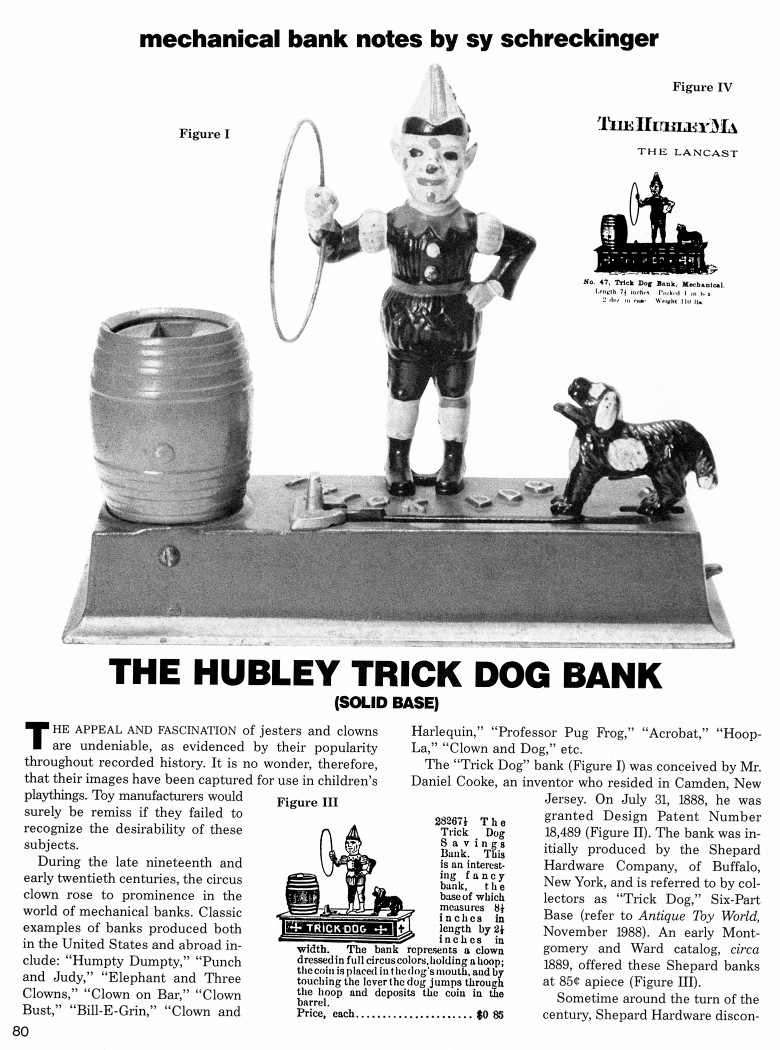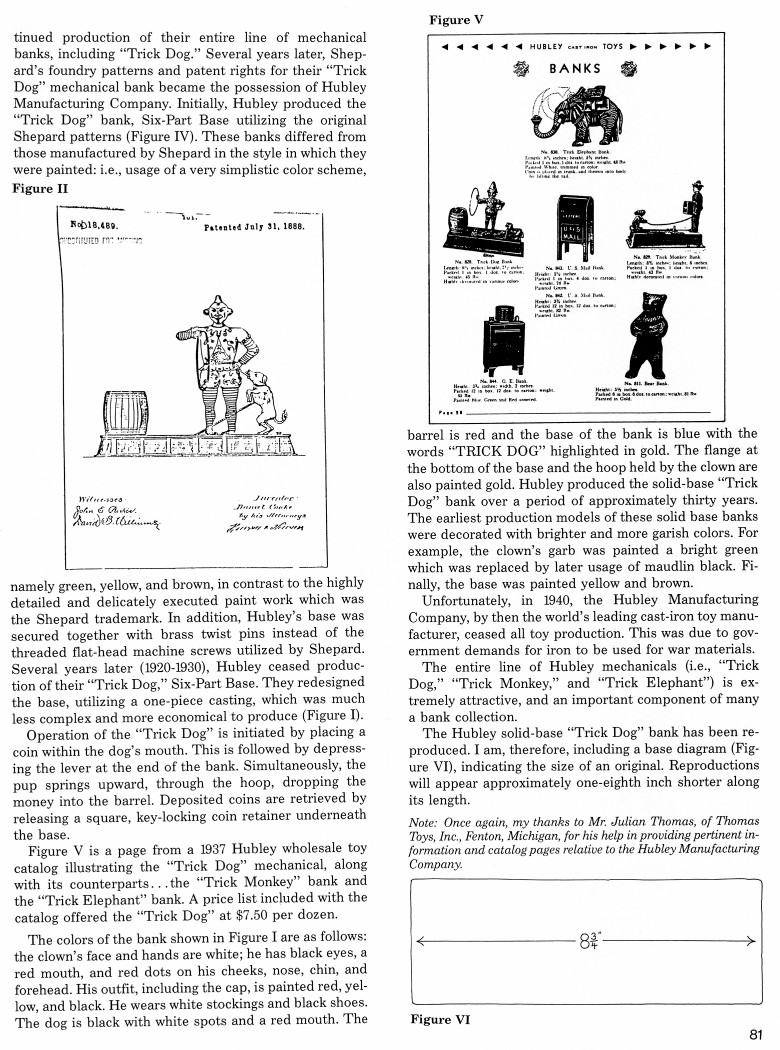|
The Hubley Trick Dog Bank
by Sy Schreckinger – ANTIQUE TOY WORLD Magazine – December, 1992
The appeal and fascination of jesters and
clowns are undeniable, as evidenced by their popularity throughout
recorded history. It is no wonder, therefore, that their images have been
captured for use in children's playthings. Toy manufacturers would surely
be remiss if they failed to recognize the desirability of these subjects.
During the late nineteenth and early twentieth centuries, the circus
clown rose to prominence in the world of mechanical banks. Classic
examples of banks produced both in the United States and abroad include:
"Humpty Dumpty," "Punch and Judy," "Elephant and Three Clowns," "Clown on
Bar," "Clown Bust," "Bill-E-Grin," "Clown and Harlequin," "Professor Pug
Frog," "Acrobat," "Hoop-La," "Clown and Dog," etc.
The "Trick Dog" bank (Figure I) was conceived by Mr. Daniel Cooke, an
inventor who resided in Camden, New Jersey. On July 31, 1888, he was
granted Design Patent Number
18,489 (Figure II). The bank was initially
produced by the Shepard Hardware Company, of Buffalo, New York, and is
referred to by collectors as "Trick Dog," Six-Part Base (refer to Antique
Toy World, November 1988). An early Montgomery and Ward catalog, circa
1889, offered these Shepard banks at 85c apiece (Figure III).
Sometime around the turn of the century, Shepard Hardware
discontinued production of their entire line of mechanical banks,
including "Trick Dog." Several years later, Shepard's foundry patterns and
patent rights for their "Trick Dog" mechanical bank became the possession
of Hubley Manufacturing Company. Initially, Hubley produced the "Trick
Dog" bank, Six-Part Base utilizing the original Shepard patterns (Figure
IV). These banks differed from those manufactured by Shepard in the style
in which they were painted: i.e., usage of a very simplistic color scheme,
namely green, yellow, and brown, in contrast to the highly detailed and
delicately executed paint work which was the Shepard trademark. In
addition, Hubley's base was secured together with brass twist pins instead
of the threaded flat-head machine screws utilized by Shepard. Several
years later (1920-1930), Hubley ceased production of their "Trick Dog,"
Six-Part Base. They redesigned the base, utilizing a one-piece casting,
which was much less complex and more economical to produce (Figure I).
Operation of the "Trick Dog" is initiated by placing a coin within
the dog's mouth. This is followed by depressing the lever at the end of
the bank. Simultaneously, the pup springs upward, through the hoop,
dropping the money into the barrel. Deposited coins are retrieved by
releasing a square, key-locking coin retainer underneath the base.
Figure V is a page from a 1937 Hubley wholesale toy catalog
illustrating the "Trick Dog" mechanical, along with its counterparts...
the "Trick Monkey" bank and the "Trick Elephant" bank. A price list
included with the catalog offered the "Trick Dog" at $7.50 per dozen.
The colors of the bank shown in Figure I are as follows: the clown's
face and hands are white; he has black eyes, a red mouth, and red dots on
his cheeks, nose, chin, and forehead. His outfit, including the cap, is
painted red, yellow, and black. He wears white stockings and black shoes.
The dog is black with white spots and a red mouth. The barrel is red and
the base of the bank is blue with the words "TRICK DOG" highlighted in
gold. The flange at the bottom of the base and the hoop held by the clown
are also painted gold. Hubley produced the solid-base "Trick Dog" bank
over a period of approximately thirty years. The earliest production
models of these solid base banks were decorated with brighter and more
garish colors. For example, the clown's garb was painted a bright green
which was replaced by later usage of maudlin black. Finally, the base was
painted yellow and brown.
Unfortunately, in 1940, the Hubley Manufacturing Company, by then the
world's leading cast-iron toy manufacturer, ceased all toy production.
This was due to government demands for iron to be used for war materials.
The entire line of Hubley mechanicals (i.e., "Trick
Dog," "Trick Monkey," and "Trick Elephant") is extremely attractive, and
an important component of many a bank collection.
The Hubley solid-base "Trick Dog" bank has been reproduced. I am,
therefore, including a base diagram (Figure VI), indicating the size of an
original. Reproductions will appear approximately one-eighth inch shorter
along its length.
Note: Once again, my thanks to Mr. Julian Thomas, of Thomas Toys,
Inc., Fenton, Michigan, for his help in providing pertinent information
and catalog pages relative to the Hubley Manufacturing Company.
|


